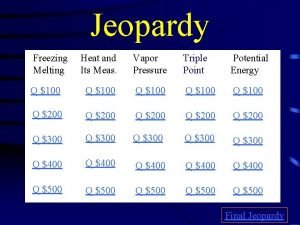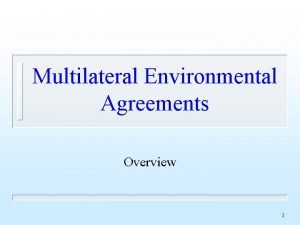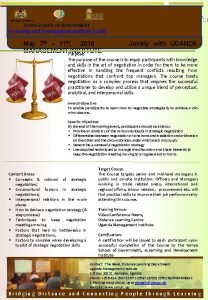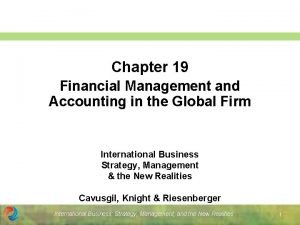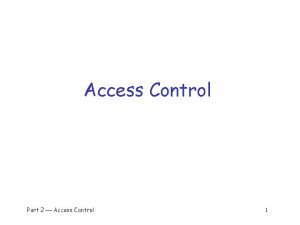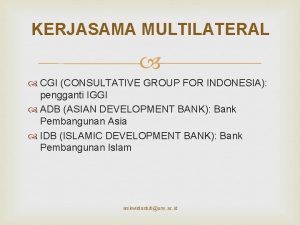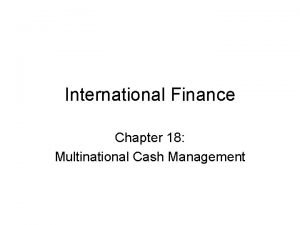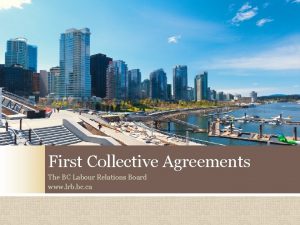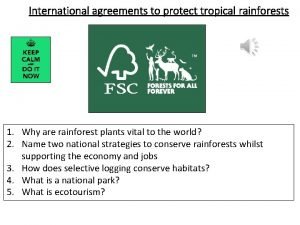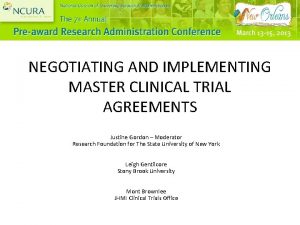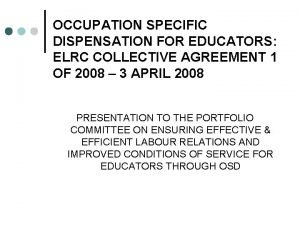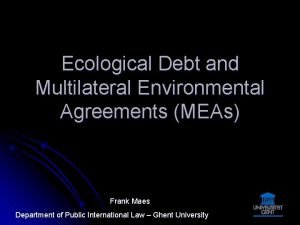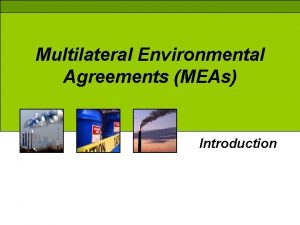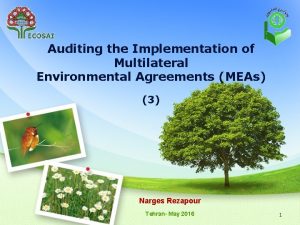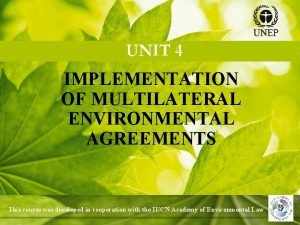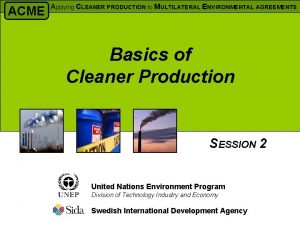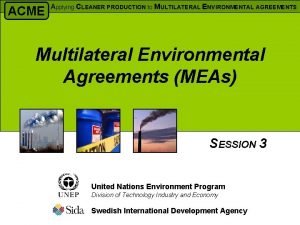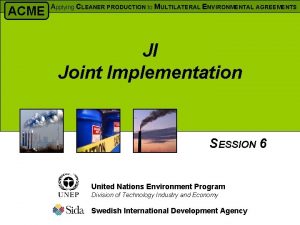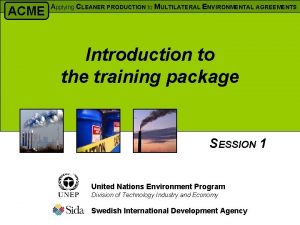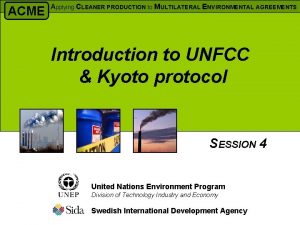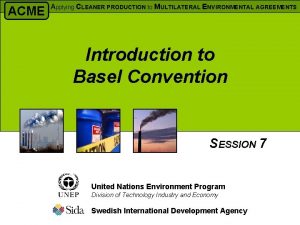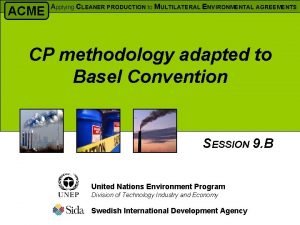NEGOTIATION OF MULTILATERAL ENVIRONMENTAL AGREEMENTS MEAs This course




















- Slides: 20

NEGOTIATION OF MULTILATERAL ENVIRONMENTAL AGREEMENTS (MEAs) This course was developed in cooperation with the IUCN Academy of Environmental Law

What is an MEA? Binding international agreement between two States (bilateral) or between three or more States (multilateral) committing to achieve specific environmental goals Can be stand-alone; e. g. Convention on International Trade in Endangered Species (CITES) Can be framework agreements (e. g. Vienna Convention for the Protection of the Ozone Layer) Binds only parties, but can affect non-parties (for example, through trade bans under CITES) This course was developed in cooperation with the IUCN Academy of Environmental Law 2

The Process of MEA Development Pre-negotiation Negotiation Adoption & signature Ratification and accession Entry into force Withdrawal from MEA This course was developed in cooperation with the IUCN Academy of Environmental Law 3

Pre-negotiation (International) Identification of a global environmental problem that warrants joint international action Start with informal consultations at international/regional level Scientific analysis: key component of pre-negotiation analysis – Scientific body may be created to investigate problem (e. g. Inter-governmental Panel on Climate Change (IPCC)) – Role of understanding in committing to move forward (contrast ozone depletion and climate change) This course was developed in cooperation with the IUCN Academy of Environmental Law 4

Pre-negotiation (International) Possible catalytic role of organizations such as: – UNEP (e. g. UNEP Governing Council decisions to launch negotiating processes) – United Nations Development Program (UNDP) – IUCN (e. g. work by the IUCN Environmental Law Centre and specialist groups of the IUCN Commission on Environmental Law to suggest new MEAs) – Economic and Social Council of the United Nations (ECOSOC) – Commission on Sustainable Development (CSD) This course was developed in cooperation with the IUCN Academy of Environmental Law 5

Pre-negotiation: National Level States need to assess: – Capacity and needs – Potential implications for implementation and enforcement at the national level – Of the issues that will be negotiated, which are the most important and what are the viable options for addressing those issues? – May include sustainability impact assessment e. g. European Union’s Trade Sustainability Impact Assessments, which assess the environmental, social and economical effects of potential agreement This course was developed in cooperation with the IUCN Academy of Environmental Law 6

Pre-negotiation: National Level In order to consider becoming involved, States need to review: – Existing legal, regulatory, and institutional frameworks – The existence of any other binding or non-binding international agreements dealing with a related issue and implications of becoming Party to another agreement – Perspectives of various stakeholders (e. g. State or provincial governments, where relevant; nongovernmental organisations (NGOs), private sector interests) This course was developed in cooperation with the IUCN Academy of Environmental Law 7

Pre-negotiation: National Level States need to develop a national position – Ideally with the involvement of all relevant national stakeholders (including State or provincial governments, NGOs, private sector, etc. in the development of national positions) – Create a forum for discussion and consultations before a national position is prepared Appoint a delegation – Mobilize a negotiating team with various skill sets – May include representatives from NGOs, private sector, or sub-national governmental bodies – Size often dependent on funding (internal and external) Preparation of briefing notes This course was developed in cooperation with the IUCN Academy of Environmental Law 8

Negotiations (1) Development of briefing statement Establishment of negotiation structure (e. g. Intergovernmental Negotiation Committee (INC)) to draft & adopt MEA INC to consist of representatives of: – governments – intergovernmental organizations – major groups (non-governmental organizations, businesses, labor organizations, etc. ) This course was developed in cooperation with the IUCN Academy of Environmental Law 9

Negotiations (2) Establishment of Preparatory Committees (Prep. Coms) to address issues related to procedure and substance Secretariat for administrative and logistical matters – Secretariat often drafts first version of MEA for discussion and negotiation Ad hoc conference(s) may be organized by INC may establish subsidiary bodies such as a Bureau and procedures for negotiations This course was developed in cooperation with the IUCN Academy of Environmental Law 10

Negotiations (3) Plenary session formal negotiations of less complex and controversial issues More complex issues referred to contact groups, subsidiary bodies, and working groups This course was developed in cooperation with the IUCN Academy of Environmental Law 11

Negotiations (4) States often form coalitions of States that have the same interests (issues or politics); this is called a “negotiating bloc” – Necessary when many States participate in the negotiations – Helps to manage the process by decreasing the number of negotiating groups – Can increase leverage and decrease costs for small and developing countries – Can advance agendas and break or modify agendas – Disadvantage: it is difficult to move between coalitions and difficult to shift from a consensus point once its This course was developed in cooperation with the IUCN Academy of Environmental Law 12 taken

Negotiations (5) Participants may make oral interventions concerning: – Country positions (including protocol regarding relationship to negotiating bloc positions) – Constraints (e. g. time limits) – Points of order & motions Note the role of textual interpretation in treaty making This course was developed in cooperation with the IUCN Academy of Environmental Law 13

Negotiations (6) Negotiating strategies: – Distributive – Integrative Negotiations may result in Statement of the Chairperson, resolutions, conclusions, recommendations, and formal decisions This course was developed in cooperation with the IUCN Academy of Environmental Law 14

Adoption and Signature Upon agreement, the final text is signed and adopted at the diplomatic conference or conference of plenipotentiaries (i. e. representatives acting with full authority of their governments) Signature by a State authenticates the text as the one finally agreed upon and indicates consent to content of negotiations and commitment to the object and purpose of the MEA – Legally, this means that the State agrees not to undermine the MEA – Signature must occur within the time period that the MEA is open for signature – Time frame is specified in the text of the MEA This course was developed in cooperation with the IUCN Academy of Environmental Law 15

Reservations to Treaty When a State becomes Party to MEA, but on condition that certain provisions do not apply – MEA may allow it, but in strict accordance with provisions of Convention (e. g. Art 309 of UNCLOS) More recent MEAs do not allow reservations (e. g. Vienna Convention, Montreal Protocol, Basel Convention) Some are silent (e. g. Espoo Convention) This course was developed in cooperation with the IUCN Academy of Environmental Law 16

Ratification and Accession States are bound when they become Party to an MEA A State becomes a Party by: – Ratification (by signatories): legislature/executive consents to treaty – Acceptance or approval: used when ratification is not explicitly provided for – Accession: occurs after the MEA comes into force; for those States which did not sign agreement when it was open for signature This course was developed in cooperation with the IUCN Academy of Environmental Law 17

Entry into Force Conditions for entry into force agreed to by Parties in the text of the MEA (during negotiation) Usually based on certain number of parties (i. e. , ratifications, accessions, acceptances, and approvals) – may also have other requirements (e. g. Kyoto Protocol) May be linked to mandatory participation of certain parties – For example, the Kyoto Protocol required: Ratification by at least 55 Parties to the UNFCC, and Ratification by Annex I Parties representing at least 55% of carbon dioxide emissions by all developed country Parties This course was developed in cooperation with the IUCN Academy of Environmental Law 18

Withdrawal from an MEA If an MEA allows for withdrawal, a State may withdraw from (denounce) the Agreement following the procedures set forth (e. g. notice period) If the MEA does not allow for withdrawal – withdrawal is possible only if it can be shown that the Parties intended to allow for withdrawal, or right of withdrawal can be implied from the agreement This course was developed in cooperation with the IUCN Academy of Environmental Law 19

Amendments/Decisions The scope of an MEA may be adjusted by way of an amendment or decision – e. g. CITES requires a decision of the Conference of the Parties to list a species on its Annexes Some MEAs require 2/3 majority (e. g. Montreal Protocol or CITES), while others require consensus (e. g. Kyoto Protocol) Amendment may require ratification If amendment is insufficient, a new agreement or protocol may be necessary (e. g. Biosafety Protocol to the Convention on Biological Diversity (CBD) This course was developed in cooperation with the IUCN Academy of Environmental Law 20
 Heat meas
Heat meas What are meas
What are meas Load fisheriris
Load fisheriris Por que meas abandonado
Por que meas abandonado Yale negotiation strategies
Yale negotiation strategies Contract negotiation course
Contract negotiation course Multilateral netting is used primarily to
Multilateral netting is used primarily to Multilateral peering japan
Multilateral peering japan The multilateral security enforces access control
The multilateral security enforces access control Xxx
Xxx Multilateral competition games
Multilateral competition games Multilateral competition games
Multilateral competition games Consultative group on indonesia bergerak dalam bidang
Consultative group on indonesia bergerak dalam bidang Cash management functions
Cash management functions Wireless health
Wireless health Supplier rebate agreements
Supplier rebate agreements Bc labour relations act
Bc labour relations act International agreements rainforest
International agreements rainforest International framework agreements
International framework agreements Master clinical trial agreements
Master clinical trial agreements Elrc collective agreements
Elrc collective agreements
